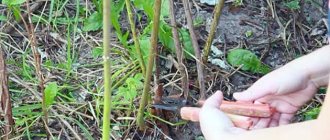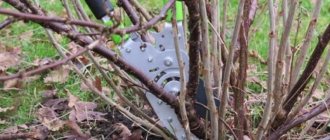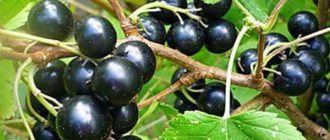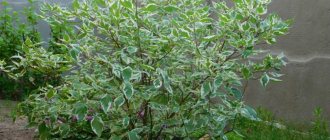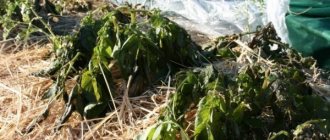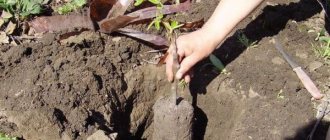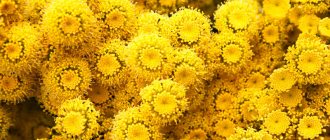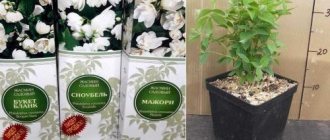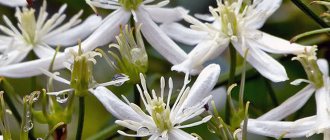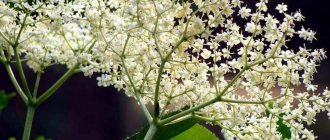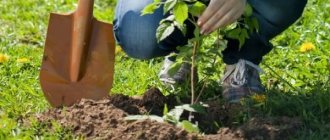Now designers are increasingly moving away from the image of a Soviet-style garden, since they do not see much beauty in it. However, berry bushes are used just as actively, only in a slightly different role. In particular, a currant hedge is fully consistent with modern trends in landscape design.
Alpine currant hedge in a park area
What currant bushes look like and are used in landscape design
Berry bushes are good in any modern garden, as they can easily and beautifully make accents or zone a space. Currants can stand alone or be used as a component in compositions from different plants.
It is also suitable in other situations:
- It can become the center of a flower arrangement - flower beds are laid out around the currants. This structure allows you to give the living area organization and rigor;
Red berries in the garden create contrasts
- Separator between plantings. For example, this is how alpine slides are framed. In this case, the currant will be a fence for other plants, preventing them from growing arbitrarily;
- Since currants can grow up to 3 meters high, they can be used as a fence for areas that need to be hidden.
It is not planted along the perimeter of the site, since the abundance of berries will attract those who like to eat, and it is inconvenient to harvest.
Reproduction
There are four ways to propagate alpine currants: using seeds, cuttings, layering and dividing the bush. The first of them involves a stratification procedure. This means that the seeds must be placed in a humid place with a cool temperature and left there for several weeks. They can be planted either directly in open ground or in boxes intended for growing seedlings. It is not recommended to bury the seeds too deeply; 0.5 cm will be enough.
Cuttings are the easiest and most convenient of the four above methods for propagating alpine currants. This process will not take much time. Material for planting is taken from young shoots located in the first row of branching, or from the root shoots. The thickness of the selected cutting should be about 0.5 cm, and its height should be at least 15-20 cm. It should be stuck into the ground with a slight slope of half its length. The best time for cuttings is early autumn. As for layering, shoots with growth and two-year-old branches are excellent for rooting.
Reproduction by dividing the bush is perhaps the most difficult method. It is used exclusively in the autumn. To do this, the bush must be dug up along with the roots. Then they are carefully examined and, depending on the degree of their development, divided into two or three parts. After that, each of them is planted in the ground, watered and mulched.
What distinguishes a currant hedge?
If you build a fence along the perimeter of the site, it is worth making some indentation from the main fence.
This will not look as effective as wood fences that can cling to a fence, but it will help create a beautiful hedge that can be viewed from the inside.
Currants are perfect for these purposes because they:
- It easily takes root in almost any climate of our country. After the plant has “mastered”, it is not afraid of either frost or drought;
- Currants do not have a thick trunk and branch from the very base. It grows widely, which allows you to create a continuous impenetrable fence. When it reaches a height of 1.5-2 meters, it becomes an excellent source of life-giving shade;
The photo shows a tall hedge of alpine blackcurrant
- It has no thorns, and the leaves are very wide, trident-shaped. In summer the leaves have a bright and rich green color, and in autumn they turn yellow;
- Currant flowers resemble bells in shape. They grow in fairly dense inflorescences;
Currant blossom
- There are many varieties that differ in height, bush shape and leaves. For hedges, preference is given to bushes that form a lush crown, for example, alpine currants.
Interesting to know! Despite its unpretentiousness, in order for it to take root in a new place, at first, greenhouse conditions are created for it to guarantee the safety of the plant.
For it you need to prepare a soil mixture consisting of soil, humus and tree bark. In the first years after transplantation, the plant also needs to be fertilized. They do this in the summer.
Read on our website: what a hedge can be.
Other shrubs for hedging in partial shade
For erecting a low hedge up to 1 meter high in a semi-shaded place, the common snowberry is also perfect. At the same time, some varieties produce not the usual white, but very unusual pink berries. In terms of care and pruning principles, the snowberry resembles a spirea. It can be trimmed regularly or left to grow freely. In the latter case, much more attractive berries will be produced.
In order to create green fences in shaded conditions, tall varieties of barberry (common, thunberg, Ottawa) and bladderwort are often used. However, it should be borne in mind that in dense shade such plants will not develop successfully, and in partial shade varieties with brightly colored foliage (purple, yellow, two-color) with a lack of sunlight will lose their intensity and become almost green.
Both European and common euonymus tolerate partial shade well, but its famous bright pink autumn color will also not be so expressive in semi-shaded places.
Green fences on the site can also be made in the form of screens entwined with perennial vines. In shady areas, virgin grapes feel good and will cope with their task in the shortest possible time.
However, one should also not forget about the aggressiveness of this vine. Shade-tolerant climbing plants such as lemongrass, actinidia, moonseed, and petiolate hydrangea will perform such work more delicately. But in order to come into full force, they will need about three years, after which the green mass will begin to grow very actively.
Currant varieties suitable for hedges
Not every variety of this shrub is suitable for creating a dense, beautiful and healthy hedge. There are 14 species in total, but only 2 of them are suitable for hedges, namely, black and golden.
Red, for example, Altai, does not have such dense foliage, but it has bright and beautiful clusters.
Alpine currant
The most common variety used as living fences is alpine currant.
This plant:
- Slow growing - adds no more than 15 cm in height per year. Reaches full height within 10-15 years.
Blackcurrant hedge
- The roots are deep, sensitive to soil density.
- Alpine is not light-loving. Feels best in partial shade and shade. If you plant it in the sun, you need to ensure constant soil moisture.
- The maximum height does not exceed 2 meters. It can reach the same size in width if there is room to grow. This property indicates savings on planting material.
Of course, the hedge will not form immediately, but after 3-4 years it will be almost complete.Indoor decorative hedge made of alpine currants
- The leaves are covered with glandular bristles. Their size is small (no more than 4 cm in length), they have three lobes, a dark green color, a jagged structure and a shiny surface.
- The branches are straight, not strongly branched. They grow densely and compactly.
- The flowers are greenish-yellow. Inflorescences are racemose.
- Berries are 6-8 mm in diameter. The color is pinkish.
Alpine currant hedge "Schmidt"
Alpine currants bloom in May for 1.5-2 weeks. Fruit ripening occurs in July-August. The berries can be left on the bush until frost. If you wish, you can pick fresh berries, but then the bushes will stand as a solid green wall.
Currant branches bear fruit for 5-6 years, after which the plant is pruned to form young shoots.
Alpine currant compares favorably with its relatives. Its leaves form a very smooth and beautiful cover. Trimmed bushes will have the correct shape without bald spots.
Golden currant
Golden currants have a purely decorative purpose. Its berries can be eaten, but their taste is not pronounced. And on the tips they form woody growths, which are very troublesome to remove.
Golden currant hedge
Golden currant blooms luxuriantly with bright yellow flowers, which is what makes it so beautiful. In autumn, its leaves can take on a variety of shades - from yellow to reddish.
With proper care, it grows up to 2.5 meters in height, so you can make a really high fence out of it, which will protect you from outside views and will not let in uninvited guests.
Golden currants are very resistant to frost and heat, for which they deserve special attention from gardeners. She rarely succumbs to pest attacks and practically does not get sick. Such a hedge can be grown even in cold regions of the country.
The variety got its name from the color of the fruits, which can be yellowish, pink and even black. The plant has medium-sized leaves of a soft green color with a yellowish tint.
Flowering begins at the end of May and continues for 2-3 weeks. The plant is a honey-bearing plant, and during the flowering period it exudes a very pleasant, unobtrusive aroma in the area.
Golden currant fruits
Golden currants begin to bloom later than black currants, which guarantees an annual harvest, because they thus avoid possible frosts, which have become so frequent in May in recent years.
Like the alpine blackcurrant, the golden currant has dense and even foliage, creating impenetrable thickets, which is required for a good hedge.
Description of golden currant
Golden currant, known among fans as ornamental, is a plant from the gooseberry family. In nature, this crop grows along the banks of rivers in North America; it was brought to Russia at the end of the 19th century, and it was a gardening rarity until Michurin drew attention to it. The Michurin variety Seedling Krandal became the ancestor of most varieties that were subsequently bred by breeders of the Soviet Union.
The wide distribution of the golden culture throughout the Soviet expanses from Moscow to the very outskirts is explained not only by Michurin’s genius, but also by the biological characteristics of the plant. It turned out that this is an ideal crop for planting in forest belts and combating drought.
Benefits of culture
- Golden currant is unpretentious and resistant to diseases and pests;
- Frost-resistant (withstands harsh winters -30 and below, usually only the tops of young shoots suffer from frost);
- Drought- and heat-resistant (leaves can withstand temperatures of 39-42 degrees without causing burns);
- Tolerates sudden changes in temperature, blooms after the end of return frosts, grows on any soil and on steep slopes.
- Requires only the most minimal care.
To all the advantages of this crop one should add such as high productivity. That's what golden currant is - real gold!
Valentina Salykovabreeder
In the most unfavorable year you will have berries.
It is not surprising that breeders from the Siberian Horticulture Research Institute became interested in this crop and began work on breeding varieties of golden currants for industrial and amateur gardening. Today, NIIS has bred ten varieties of golden currant (out of 23 varieties included in Rosreestr). All varieties of golden currant are so resistant to fungal and viral diseases and most pests, including bud mites, that, according to Valentina Stepanovna, “chemical treatment is excluded.” Also, all varieties of golden currant are early-bearing, and after a short time, already in the second or third year after planting, they are able to produce a good harvest (for selected forms of the crop, the average yield is 4-5 kg per bush).
Valentina Salykova
Golden currant can grow next to a fence, where there is not enough light, and can withstand growing conditions in large cities and industrial centers where the air is polluted.
Golden currant varieties selected by the Lisavenko Research Institute
- Barnaul
- Valentina
- Gift of Altai
- Ida
- Levushka
- Gift to Ariadne
- 3594-99-8 (№3)
- droplet
- Ribes aureum 2-7
- Otrada
- Siberian sun
The process of planting a currant hedge
Proper planting in compliance with the optimal time for this is a guarantee of high survival rate of the plant.
Planting a blackcurrant bush
- The first stage is the most labor-intensive and time-consuming. This is marking the territory and digging holes for planting. To do this, you need to draw up a plan of the site to scale, or do everything on the spot, trying everything on without your eyes. For work, pegs and nylon thread are used.
- If the hedge is round in shape, it is necessary to determine the planting points by making a multi-faceted structure. Smooth curves will be given to the plantings by cutting.
- The bushes are planted at a distance of 50-60 cm from each other. There is no need to perfectly align the planting line - displacements of a few centimeters will not be noticeable - all this can be easily aligned when trimming the bushes. However, a guideline is needed, since the first serious haircut will not be in 1 year, and admiring the crooked rows before that will not bring pleasure.
- Next, with a precise step, holes are dug, reaching a depth of 40 cm and a diameter of 50 cm.
- Add the prepared soil mixture to each hole. A kilogram of tree bark and 200 grams are enough for one plant. humus. All this is mixed with soil and poured into the bottom of the hole.
- Next, the seedlings are buried. This technique means planting the plant at an angle of 45 degrees, so that not only the root, but also part of the trunk with buds remains underground. This will allow the plant to take root faster and better.
Correct placement of currant seedlings when planting
Tip! The plant will not remain in this position. Quite quickly it will straighten and rush upward. New shoots will also take the correct position.
- Before planting, pour about a bucket of water into the prepared hole with fertilizer.
- The seedling is sprinkled with earth, which is carefully compacted so that a depression with sides is formed around the plant. Another bucket of water is poured into it. The liquid, seeping through the soil, will carry along small loosened soil particles, compacting them. During this process, the roots of the plant will be tightly covered with soil, which will guarantee good contact with the nutrient medium.
- Immediately after planting, the plant can be pruned to provoke rapid development of shoots in the first year. It is necessary to cut off the main part from each existing shoot, leaving about 10-15 cm of their length.
Scheme for pruning currants
Pruning is done at an angle of 30-40 degrees.
The most optimal time for planting currant bushes is late summer or autumn. In spring, currants will delight you with young, strong shoots.
Read on our website: what fences to use for currant bushes.
Currants - shelter for the winter
Sheltering currants for the winter is an important part of preparing the plant for winter.
Currants have good winter hardiness, so when they grow in the south or central Russia, they do not need special preparation. After harvesting, it is enough to treat the bush to protect it from diseases and pests, as well as fertilize the soil. To do this, fertilizing is applied to the dug up soil, which can be urea. Then phosphorus-potassium fertilizers are applied to the soil. The old mulch is replaced with a new one - dry grass or sawdust.
Proper pruning will also help the plant survive the winter. During this process, old and diseased shoots are removed and burned along with fallen leaves.
In harsher climates with cold, snowy winters, currants may require tying and shelter.
To prevent branches from being damaged by bad weather, they must be tied in a vertical position. They tie the bush with twine, starting from the bottom and moving up. The top should be pulled tighter than the base. The branches are distributed in a spiral manner.
Important: Do not pull the branches too tightly so that this does not cause damage to the stems.
In severe frosts of -30° or more, currant bushes can be covered with insulation. The covering material must allow air to pass through well, otherwise the plant may suffocate. The use of polyethylene to cover bushes is unacceptable. If there is no need to cover the plant with special materials, you can simply cover the base of the bush with a thick layer of snow.
Currant hedge care
In order for a hedge to be healthy and beautiful, the bushes must be cared for on time. In particular, when the plant grows to 60 cm, it begins to be actively trimmed, giving it the desired shape.
If this moment is missed, the bush will grow greatly, its shoots at the base will become rigid, and it will be more difficult to manage all this.
Currant pruning
Black currants, whose branches spread in all directions, will cause a lot of trouble. You definitely won’t get any beautiful hedge, just a dense, overgrown and shapeless strip.
After planting, the plant quickly takes root, but during the first 2-3 years it is recommended to fertilize it, doing this 1-2 times a year. Organic fertilizers are better suited for this.
Such care will allow the bushes to quickly develop and become a full-fledged hedge. Berries for compote for 1-2 years will be a wonderful and tasty reward.
Depending on the growth rate
Since most hedges are created with the goal of protecting the area from anyone or anything (neighbors, animals, noise, snow, wind, etc.), fast-growing shrubs become the priority choice. These include:
- Thunberg barberry;
- rose hip;
- European beech;
- vesicular carp;
- common hornbeam;
- hawthorn;
- snowberry;
- Leyland's cupressociparis;
- cherry laurel;
- Thuja occidentalis Brabant.
Shrubs of moderate growth (you will have to wait 3-4 years) include:
- common privet;
- viburnum;
- Tatarian honeysuckle;
- Elf angustifolia and silver;
- broom;
- alpine currant;
- Tatarian maple.
If there is nowhere to rush, you can plant slow-growing shrubs as a green fence, but gardeners rarely resort to this step:
- irga;
- mahonia holly;
- brilliant cotoneaster;
- red cedar;
- holly;
- boxwood;
- sea buckthorn;
- yew.
Fast-growing shrubs as part of a hedge are also beneficial because if one plant disappears, a young shoot can be planted in its place - and it will soon close the gaping hole. This will not work with slow-growing ones.
Landscape design techniques with currants in the garden
Berry bushes can play the role of accent decorations, as well as limit the development of other vegetation, but that’s not all, there are other solutions for using this wonderful plant.
Options for planting currants in the form of a hedge
Due to the fact that currants can grow well in height, multi-level compositions can be planted from them.
This technique is perfect for a site with uneven terrain (read the article about landscape design of a site on a slope). Alpine hills can also be improved, creating parallels. In this case, the hedge will become an accent.
Berry gardens look attractive. Due to the density of the foliage, an additional quiet seating area will be created, in which benches can be installed.
Hedges in landscape design
Viburnum gordovina - not affected by aphids
Viburnum common - a bright shrub with clusters of coral berries and lobed foliage similar to maple leaves, is well known to people even far from gardening. But for creating a hedge, another type of this plant is much more suitable - viburnum gordovina.
Viburnum gourdovina is excellent for creating a hedge in partial shade. James M
This variety is a dense shrub up to four meters high with a dense but compact crown. This species differs from the common viburnum in its large pubescent leaves covered with white hairs, which give the impression of velvet.
Viburnum pride blooms profusely in May–June with white inflorescences, after which the bushes bear attractive bright berries of red and black color. The main advantage of this crop over the common viburnum is that this shrub is not affected by aphids.
Planting a hedge of viburnum gordovina and care
In order to create a hedge, 2-3 year old plants are planted at a distance of 30-40 centimeters from each other. Viburnum pride loves fertile, well-moistened soils. Therefore, during drought, it will need watering, even after the plants have taken root well.
In the second year, at the beginning of summer, young growth can be pruned by 2-3 nodes to enhance the branching of the bush. Next, the formation of a hedge from the pride viburnum will involve removing old shoots that are too thick. Only the tops of young stems are pinched.
This type of viburnum is most suitable for creating a free-growing screen, and should be subjected to minimal pruning. In plants with such large leaves and thick stems, strong excessive pruning will not look entirely harmonious. The overall lifespan of the shrub is long (about 60 years), so such a hedge will perform its function for many years.
Advantages of a hedge made from viburnum gordovina
- grows well in both shade and partial shade;
- viburnum gourdovina is unpretentious in care and is more drought-resistant than common viburnum;
- the bush has edible sweetish fruits;
- during the fruiting period, this viburnum is very decorative, its glossy berries are initially red, and then they turn black;
- The fruits of this viburnum are edible; they taste sweet and juicy.
Disadvantages of a fence made from viburnum gordovina
- in comparison with other shrubs, it reacts poorly to drought and needs watering;
- the bush grows relatively slowly;
- the plant will not do well on peat, sandy and podzolic soils.
After the flowering of the viburnum, the bushes begin to bear attractive bright berries of red and black color. Oregon State University
Features of growing currant bushes
To grow a blackcurrant hedge, it is recommended to follow the basic advice of experts. Step-by-step completion of the work is the key to a high-quality final result.
Why do you need supports for currants?
Support is needed for proper formation of the bush. Thanks to the support, the plant takes up less space on the site, and it is easier for gardeners to harvest. The shrub is more well-groomed; the branches do not fall down or sag under the weight of ripe fruits.
It is also easier for summer residents to work with the soil: water, fertilize, loosen and mulch. In winter, covering material is fixed to the fences, which protects the bushes from gusty winds and frosts.
If currants grow without supports, the branches lie on the ground, and the fruits come into contact with the ground, which causes diseases. If the ground is wet, the berries become covered with plaque, mold or rot. When caring for shrubs, you have to lift the shoots yourself with one hand - this is inconvenient.
Ready-made bush holders (purchased)
To save time and effort, purchase bush holders and trellises at a specialty store or order online.
The price of ready-made fencing starts from 129 rubles.
You can choose fencing of all colors and shapes, made from different materials. This article will tell you about planting currants in the spring.
It is important to choose not only a beautiful fence, but also to ensure that it is durable. The service life depends entirely on this.
Metal fences
Very strong and resistant to any weather conditions. Forged metal fences will decorate your garden area. These supports are not removed during the cold season; they are usually coated with a special powder that has an anti-corrosion effect.
Forged products will cost more than regular metal ones.
Plastic stands
Plastic coasters are strong, but not as stable as metal ones. A distinctive feature is that they are light in weight and also easy to assemble. It takes a novice gardener who has no experience or skills to assemble such a fence no more than 10-15 minutes. Convenient to transport, easy to disassemble and assemble to support another bush. The downside is the high price and in gusty winds the structure becomes deformed or even falls down.
What materials will be required for self-fencing of shrubs?
For the full construction of a wooden fence, the following materials will be useful:
- picket fence or bars;
- stakes from various trees;
- white spirit or yacht varnish and a brush for it;
- several screws measuring 4 by 50 and 5 by 80 mm;
- tape measures of 3 and 10 meters;
- level and axe;
- saw, preferably a circular saw, maybe a grinder and a corner saw;
- hacksaw, plane;
- battery powered drill;
- screwdriver, hammer.
It all depends on the chosen fencing option. An old hoop, table top, wire, the rim of an old bicycle wheel, rope and many other materials that have come out of their own functionality can be used as the main material; it all depends on imagination and the possibility of manufacturing.
Let's take a closer look at the recommendations for the necessary materials.
Why is it better to use yacht varnish? The reason is its characteristics and resistance to environmental influences.
If you are using a block more than half a meter long, use a saw to divide it into 8 equal parts. If you use ready-made picket fences as holders, then shorten them to 1/3 of the height of the bush. The bars are sharpened with an ax, and the stakes are processed using a plane before applying varnish. White spirit is used to rinse brushes after applying varnish.
Screws are required to secure all parts together. Each part is varnished separately, and the second layer is applied to the finished product.

